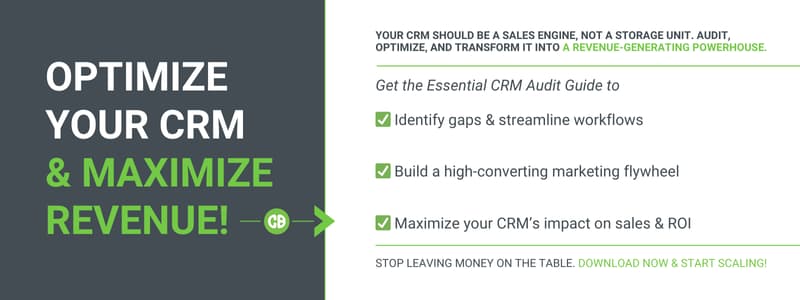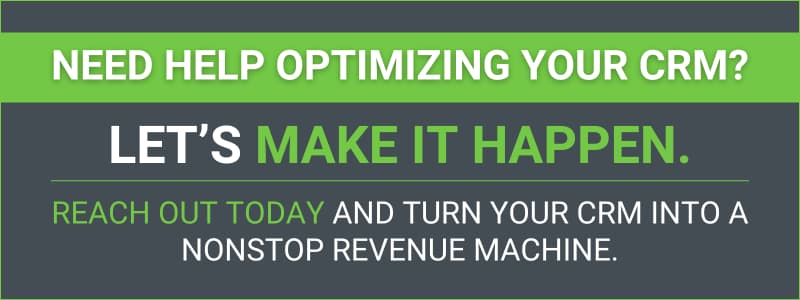Unlock the full power of your CRM to drive engagement, close deals faster, and eliminate sales bottlenecks. Learn how automation, data insights, and streamlined workflows can transform your CRM from a static database into a high-performing revenue engine.
Your CRM should be the ultimate sales accelerator, keeping leads engaged, automating time-consuming tasks, and ensuring no deal falls through the cracks. But too often, businesses treat their CRM like a glorified address book, failing to harness its full potential. The result? Slower sales cycles missed revenue opportunities, and frustrated teams drowning in manual work.
Here’s the fix: CRM workflows that work for you—not against you.
In this article, we’ll break down how to automate, optimize, and scale your sales process using CRM workflows. You'll learn:
- How automation eliminates busywork so your sales team can focus on closing deals.
- How to nurture leads effortlessly with personalized, data-driven touchpoints.
- Why data insights matter—and how to use them to refine your strategy.
- Essential workflows for scalable growth that help you track opportunities, assign leads, and drive conversions.
- Optimization tactics to transform your CRM into a true revenue engine.
If you’re ready to work smarter, close faster, and grow without limits, let’s dive in.
How CRM Workflows Supercharge Sales
CRM workflows aren’t just another tech feature—they’re the engine that keeps your sales machine running at full throttle. When done right, they take the grunt work off your plate, keep leads engaged, and make sure nothing (and no one) slips through the cracks.
Automate, Accelerate, Close More Deals
Your sales team should be selling, not drowning in admin tasks. With CRM automation, you unlock efficiency that translates directly into revenue.
- Lead scoring. Stop wasting time on cold leads. Automate scoring based on engagement, demographics, and behavior so your sales team focuses on the hottest prospects.
- Follow-ups. Never drop the ball again. CRM-triggered follow-ups keep conversations alive and moving when they matter most.
- Data entry. Forget manual logging—your CRM can handle call logs, contact updates, and notes automatically.
- Email campaigns. Send the right message at the right time. CRM-driven automation delivers personalized, behavior-based outreach that keeps leads engaged.
- Appointment scheduling. Let your CRM handle bookings, sync calendars, and send reminders so your team can sell instead of schedule.
- Support ticket routing. Direct inquiries to the right rep in real time, ensuring faster resolutions and happier customers.
CRM workflows aren’t just about efficiency—they’re about closing more deals, faster. When your system is dialed in, your sales team spends less time on admin and more time doing what they do best: building relationships, negotiating, and winning.
"Let your CRM do the heavy lifting—so your sales team can do the selling."

Enhanced Lead Nurturing
Your leads deserve more than generic follow-ups and cold outreach. With automated workflows, you keep them engaged without adding to your team’s workload. More conversions, less manual effort—here’s how:
- Personalized email campaigns. Deliver content that actually resonates. Whether it’s an educational series for prospects eyeing a specific product or a follow-up to a demo request, automation makes it personal at scale.
- Re-engagement campaigns. Ghosted by a lead? No problem. Automated workflows re-engage users who haven't interacted recently, keeping your pipeline warm and conversations alive.
- Segmentation and targeting. Your leads aren’t all the same—so why treat them that way? Automatically group them by behavior, demographics, or engagement level for laser-focused marketing that converts.
Companies that nail lead nurturing generate 50% more sales-ready leads at a 33% lower cost. If you’re not automating, you’re leaving deals on the table.
Data-Driven Insights
Your CRM is more than a database—it’s a goldmine of insights waiting to be tapped. With the right workflows, you’re not just collecting data—you’re turning it into strategy. Here’s how automation makes your CRM work for you:
- Customer behavior analysis: Stop guessing, start knowing. Automatically track and analyze interactions across every touchpoint, so your sales team delivers personalized, high-impact outreach.
- Sales performance metrics. No more flying blind. Get instant insights into conversion rates, pipeline health, and sales activities—so leaders can make smarter decisions and pivot fast.
- Predictive analytics. Want to see the future? Use historical data to forecast trends, customer behavior, and revenue opportunities—so you’re always ahead of the game.
Companies that leverage CRM data effectively see a 29% increase in sales and a 34% boost in sales productivity.
When you use your CRM, you can turn insights into action and build a sales engine that runs on real-time data and unstoppable momentum.
Essential Workflows for Scalable Growth
If your sales process isn’t scalable, it’s stuck. The right CRM workflows don’t just keep things moving—they supercharge growth by automating what matters most. Here’s how:
1.Lead Assignment
Prospects shouldn’t sit in limbo. Automate lead distribution so the right rep gets the right lead—instantly.
- Round-robin distribution. Spread leads evenly among your sales team, preventing burnout and keeping workloads balanced.
- Criteria-based assignment. Assign leads based on industry, location, or interest, ensuring prospects connect with reps who actually know their stuff.
Why it matters? Leads go to the best-fit rep, response times shrink, and conversions skyrocket.
2. Automated Follow-Ups
Consistency wins sales. Forget manual reminders—let your CRM handle follow-ups on autopilot.
- Post-interaction follow-ups. Engaged leads shouldn’t go cold. Whether they downloaded a guide or attended a webinar, send personalized, timely messages to keep the momentum alive
- Inactivity reminders. Prospects ghosting you? Your CRM triggers alerts and re-engagement emails before opportunities slip away.
Why it matters? No more lost leads, no more human error—just steady, strategic follow-ups that drive revenue.
3. Opportunity Tracking
If you don’t track your deals, you can’t grow your pipeline. CRM-powered tracking makes sales forecasting effortless.
- Visual pipeline management. Get a clear, real-time view of deal stages and identify bottlenecks before they stall momentum.
- Stage-specific actions. Automate critical steps—like sending proposals at negotiation or scheduling demos at evaluation—to speed up the closing process.
Why it matters? Faster deals, smarter decisions, and a pipeline that scales without breaking.
Optimizing Your CRM for Maximum Impact
Your CRM should be the engine driving sales, retention, and revenue. But if you’re not optimizing it, you’re leaving money on the table. Here’s how to make your CRM work harder and smarter:
1. Audit current workflows
If your CRM feels clunky, it probably is. Reviewing workflows helps eliminate bottlenecks and keeps your system agile. Businesses that regularly audit processes boost data reliability and keep their growth funnel fast and friction-free.

2. Integrate sales and marketing strategies
Disconnected teams = disconnected customer experiences. When sales and marketing share data, goals, and strategies, conversion rates skyrocket. Companies with misaligned teams were twice as likely to experience a 20%+ revenue decline year-over-year.
3. Leverage analytics for continuous improvement
Use analytics to track performance, spot trends, and fine-tune your strategy in real time. By breaking down customer interactions, sales patterns, and marketing impact, you can double down on what’s working and ditch what’s not. And here’s the kicker: 57% of businesses see a direct sales boost from CRM-driven insights. That’s the power of data-driven decision-making—more revenue, less guesswork.
Businesses that use CRM analytics effectively see higher conversions and better sales efficiency. If your CRM isn’t feeding your strategy, you’re leaving revenue on the table.
Make Your CRM Work for You—Not Against You
Your CRM isn’t just another tool—it should be the engine driving your revenue growth. When workflows are optimized, leads stay engaged, sales cycles move faster, and your team spends less time on admin and more time closing deals. But if you’re not leveraging automation, data insights, and strategic workflows, you’re leaving money on the table.
Ready to Supercharge Your CRM and Drive More Revenue?
Stop letting leads slip through the cracks and start closing deals faster. The right CRM strategy can transform your pipeline, boost sales efficiency, and help you scale with confidence.
🔹 Audit your workflows. Identify gaps and automate where it matters.
🔹 Align your sales and marketing teams. A connected strategy means better conversions.
🔹 Leverage your data. Insights drive decisions—and revenue.

.jpg?width=1000&name=25.2.1.4%20Featured%20(1).jpg)